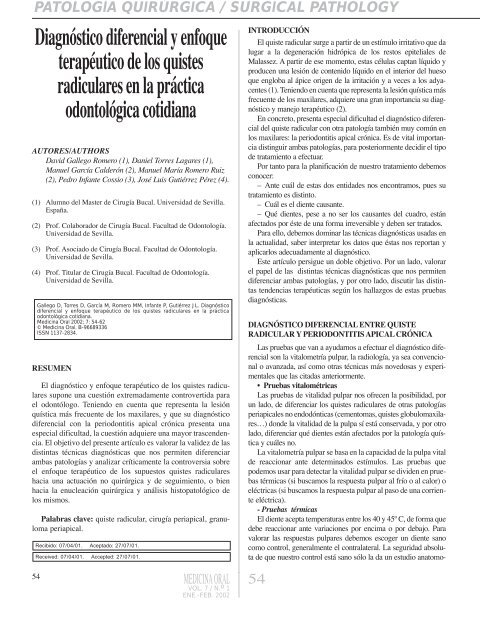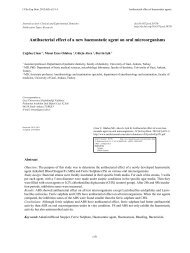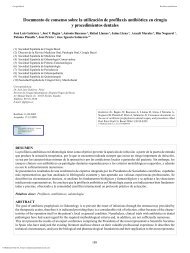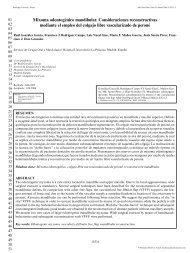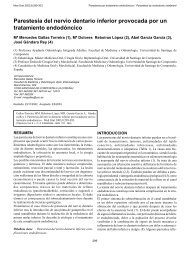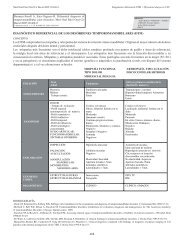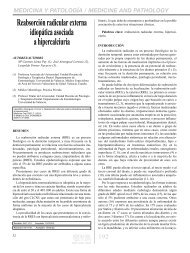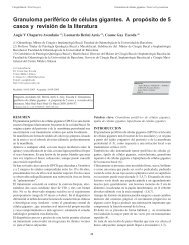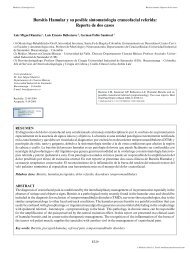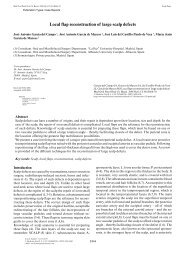Diagnóstico diferencial y enfoque terapéutico de los ... - Medicina Oral
Diagnóstico diferencial y enfoque terapéutico de los ... - Medicina Oral
Diagnóstico diferencial y enfoque terapéutico de los ... - Medicina Oral
Create successful ePaper yourself
Turn your PDF publications into a flip-book with our unique Google optimized e-Paper software.
PATOLOGÍA QUIRÚRGICA / SURGICAL PATHOLOGY<br />
Diagn—stico <strong>diferencial</strong> y <strong>enfoque</strong><br />
terapŽutico <strong>de</strong> <strong>los</strong> quistes<br />
radiculares en la pr‡ctica<br />
odontol—gica cotidiana<br />
AUTORES/AUTHORS<br />
David Gallego Romero (1), Daniel Torres Lagares (1),<br />
Manuel Garc’a Cal<strong>de</strong>r—n (2), Manuel Mar’a Romero Ruiz<br />
(2), Pedro Infante Cossio (3), JosŽ Luis GutiŽrrez PŽrez (4).<br />
(1) Alumno <strong>de</strong>l Master <strong>de</strong> Cirug’a Bucal. Universidad <strong>de</strong> Sevilla.<br />
Espa–a.<br />
(2) Prof. Colaborador <strong>de</strong> Cirug’a Bucal. Facultad <strong>de</strong> Odontolog’a.<br />
Universidad <strong>de</strong> Sevilla.<br />
(3) Prof. Asociado <strong>de</strong> Cirug’a Bucal. Facultad <strong>de</strong> Odontolog’a.<br />
Universidad <strong>de</strong> Sevilla.<br />
(4) Prof. Titular <strong>de</strong> Cirug’a Bucal. Facultad <strong>de</strong> Odontolog’a.<br />
Universidad <strong>de</strong> Sevilla.<br />
Gallego D, Torres D, García M, Romero MM, Infante P, Gutiérrez JL. <strong>Diagnóstico</strong><br />
<strong>diferencial</strong> y <strong>enfoque</strong> <strong>terapéutico</strong> <strong>de</strong> <strong>los</strong> quistes radiculares en la práctica<br />
odontológica cotidiana.<br />
<strong>Medicina</strong> <strong>Oral</strong> 2002; 7: 54-62<br />
© <strong>Medicina</strong> <strong>Oral</strong>. B-96689336<br />
ISSN 1137-2834.<br />
RESUMEN<br />
El diagn—stico y <strong>enfoque</strong> terapŽutico <strong>de</strong> <strong>los</strong> quistes radiculares<br />
supone una cuesti—n extremadamente controvertida para<br />
el odont—logo. Teniendo en cuenta que representa la lesi—n<br />
qu’stica m‡s frecuente <strong>de</strong> <strong>los</strong> maxilares, y que su diagn—stico<br />
<strong>diferencial</strong> con la periodontitis apical cr—nica presenta una<br />
especial dificultad, la cuesti—n adquiere una mayor trascen<strong>de</strong>ncia.<br />
El objetivo <strong>de</strong>l presente art’culo es valorar la vali<strong>de</strong>z <strong>de</strong> las<br />
distintas tŽcnicas diagn—sticas que nos permiten diferenciar<br />
ambas patolog’as y analizar cr’ticamente la controversia sobre<br />
el <strong>enfoque</strong> terapŽutico <strong>de</strong> <strong>los</strong> supuestos quistes radiculares<br />
hacia una actuaci—n no quirœrgica y <strong>de</strong> seguimiento, o bien<br />
hacia la enucleaci—n quirœrgica y an‡lisis histopatol—gico <strong>de</strong><br />
<strong>los</strong> mismos.<br />
Palabras clave: quiste radicular, cirug’a periapical, granuloma<br />
periapical.<br />
Recibido: 07/04/01. Aceptado: 27/07/01.<br />
Received: 07/04/01. Accepted: 27/07/01.<br />
54<br />
MEDICINA ORAL<br />
VOL. 7 / N. o 1<br />
ENE.-FEB. 2002<br />
INTRODUCCIîN<br />
El quiste radicular surge a partir <strong>de</strong> un est’mulo irritativo que da<br />
lugar a la <strong>de</strong>generaci—n hidr—pica <strong>de</strong> <strong>los</strong> restos epiteliales <strong>de</strong><br />
Malassez. A partir <strong>de</strong> ese momento, estas cŽlulas captan l’quido y<br />
producen una lesi—n <strong>de</strong> contenido l’quido en el interior <strong>de</strong>l hueso<br />
que engloba al ‡pice origen <strong>de</strong> la irritaci—n y a veces a <strong>los</strong> adyacentes<br />
(1). Teniendo en cuenta que representa la lesi—n qu’stica m‡s<br />
frecuente <strong>de</strong> <strong>los</strong> maxilares, adquiere una gran importancia su diagn—stico<br />
y manejo terapŽutico (2).<br />
En concreto, presenta especial dificultad el diagn—stico <strong>diferencial</strong><br />
<strong>de</strong>l quiste radicular con otra patolog’a tambiŽn muy comœn en<br />
<strong>los</strong> maxilares: la periodontitis apical cr—nica. Es <strong>de</strong> vital importancia<br />
distinguir ambas patolog’as, para posteriormente <strong>de</strong>cidir el tipo<br />
<strong>de</strong> tratamiento a efectuar.<br />
Por tanto para la planificaci—n <strong>de</strong> nuestro tratamiento <strong>de</strong>bemos<br />
conocer:<br />
Ð Ante cu‡l <strong>de</strong> estas dos entida<strong>de</strong>s nos encontramos, pues su<br />
tratamiento es distinto.<br />
Ð Cu‡l es el diente causante.<br />
Ð QuŽ dientes, pese a no ser <strong>los</strong> causantes <strong>de</strong>l cuadro, est‡n<br />
afectados por Žste <strong>de</strong> una forma irreversible y <strong>de</strong>ben ser tratados.<br />
Para ello, <strong>de</strong>bemos dominar las tŽcnicas diagn—sticas usadas en<br />
la actualidad, saber interpretar <strong>los</strong> datos que Žstas nos reportan y<br />
aplicar<strong>los</strong> a<strong>de</strong>cuadamente al diagn—stico.<br />
Este art’culo persigue un doble objetivo. Por un lado, valorar<br />
el papel <strong>de</strong> las distintas tŽcnicas diagn—sticas que nos permiten<br />
diferenciar ambas patolog’as, y por otro lado, discutir las distintas<br />
ten<strong>de</strong>ncias terapŽuticas segœn <strong>los</strong> hallazgos <strong>de</strong> estas pruebas<br />
diagn—sticas.<br />
DIAGNîSTICO DIFERENCIAL ENTRE QUISTE<br />
RADICULAR Y PERIODONTITIS APICAL CRîNICA<br />
Las pruebas que van a ayudarnos a efectuar el diagn—stico <strong>diferencial</strong><br />
son la vitalometr’a pulpar, la radiolog’a, ya sea convencional<br />
o avanzada, as’ como otras tŽcnicas m‡s novedosas y experimentales<br />
que las citadas anteriormente.<br />
¥ Pruebas vitalomŽtricas<br />
Las pruebas <strong>de</strong> vitalidad pulpar nos ofrecen la posibilidad, por<br />
un lado, <strong>de</strong> diferenciar <strong>los</strong> quistes radiculares <strong>de</strong> otras patolog’as<br />
periapicales no endod—nticas (cementomas, quistes globulomaxilaresÉ)<br />
don<strong>de</strong> la vitalidad <strong>de</strong> la pulpa s’ est‡ conservada, y por otro<br />
lado, diferenciar quŽ dientes est‡n afectados por la patolog’a qu’stica<br />
y cu‡les no.<br />
La vitalometr’a pulpar se basa en la capacidad <strong>de</strong> la pulpa vital<br />
<strong>de</strong> reaccionar ante <strong>de</strong>terminados est’mu<strong>los</strong>. Las pruebas que<br />
po<strong>de</strong>mos usar para <strong>de</strong>tectar la vitalidad pulpar se divi<strong>de</strong>n en pruebas<br />
tŽrmicas (si buscamos la respuesta pulpar al fr’o o al calor) o<br />
elŽctricas (si buscamos la respuesta pulpar al paso <strong>de</strong> una corriente<br />
elŽctrica).<br />
- Pruebas tŽrmicas<br />
El diente acepta temperaturas entre <strong>los</strong> 40 y 45¼ C, <strong>de</strong> forma que<br />
<strong>de</strong>be reaccionar ante variaciones por encima o por <strong>de</strong>bajo. Para<br />
valorar las respuestas pulpares <strong>de</strong>bemos escoger un diente sano<br />
como control, generalmente el contralateral. La seguridad absoluta<br />
<strong>de</strong> que nuestro control est‡ sano s—lo la da un estudio anatomo-<br />
54
QUISTES RADICULARES/<br />
<strong>Medicina</strong> <strong>Oral</strong> 2002; 7: 54-62 PERIAPICAL CYSTS<br />
patol—gico, algo que obviamente no po<strong>de</strong>mos hacer, por lo que este<br />
error no po<strong>de</strong>mos subsanarlo y tenemos que asumirlo como inevitable.<br />
DespuŽs <strong>de</strong> instruir al paciente sobre la prueba, realizamos<br />
Žsta sobre el diente siguiendo la siguiente secuencia: primero aplicamos<br />
el est’mulo en la cara oclusal o bor<strong>de</strong> incisal, <strong>de</strong>spuŽs en la<br />
cara vestibular; si no conseguimos respuesta estimulamos el ‡rea<br />
cervical y finalmente aplicamos el fr’o o el calor sobre la caries (si<br />
la hubiera).<br />
Ya Kantorowich (3), en 1937, public— un gr‡fico en las que relacionaba<br />
la temperatura a que se estimulaba las fibras nerviosas pulpares<br />
y el proceso que ocurr’a en ella, fuera Žste patol—gico o no.<br />
Esta visi—n est‡ totalmente superada y la utilidad <strong>de</strong> las pruebas<br />
vitales s—lo se acepta para <strong>de</strong>mostrar la vitalidad o no vitalidad pulpar,<br />
sin discriminar entre <strong>los</strong> cuadros patol—gicos que pue<strong>de</strong>n estar<br />
sucediendo.<br />
Humford <strong>de</strong>scribe el uso <strong>de</strong> la gutapercha caliente para la realizaci—n<br />
<strong>de</strong> estas pruebas. Con respecto a las pruebas tŽrmicas basadas<br />
en el fr’o se han usado trocitos <strong>de</strong> hielo (Dachi), nieve carb—nica<br />
(Obwegeser y Stein Hauser), cloruro <strong>de</strong> etilo y m‡s mo<strong>de</strong>rnamente<br />
diclordifluormetano. La principal <strong>de</strong>sventaja <strong>de</strong> estas pruebas<br />
es que la temperatura a que sometemos el diente es dif’cilmente<br />
objetivable (3).<br />
Ð Pruebas elŽctricas<br />
En este grupo <strong>de</strong> pruebas el est’mulo (una corriente elŽctrica) es<br />
objetivable con facilidad. Los primeros estudios se remontan a la<br />
dŽcada <strong>de</strong> <strong>los</strong> 60. Reynolds (3) consigue diferenciar entre dientes<br />
vitales y no vitales, pero no correlaciona la intensidad <strong>de</strong> la corriente<br />
a la que estimula la pulpa con la patolog’a pulpar subyacente.<br />
Esta exploraci—n, si bien tiene las ventajas citada anteriormente,<br />
tambiŽn presenta inconvenientes:<br />
Ð Es fundamental eliminar el temor <strong>de</strong>l paciente a la prueba, <strong>de</strong><br />
lo contrario, Žste pue<strong>de</strong> interferir en <strong>los</strong> resultados <strong>de</strong> la exploraci—n.<br />
Ð No pue<strong>de</strong> ser realizado en pacientes con marcapasos, por el<br />
peligro que tiene <strong>de</strong> interferir en el<strong>los</strong>.<br />
Ð La calcificaci—n <strong>de</strong> <strong>los</strong> canales pulpares pue<strong>de</strong> disminuir la<br />
reacci—n pulpar al est’mulo, por lo que <strong>de</strong>beremos valorar este<br />
aspecto en la radiograf’a. TambiŽn <strong>de</strong>bemos evaluar situaciones<br />
especiales como dientes en tratamiento ortod—ncico o con restauraciones<br />
o traumatismos recientes.<br />
Ð Las restauraciones con amalgama <strong>de</strong> plata y las coronas met‡licas<br />
<strong>de</strong>sv’an la corriente a <strong>los</strong> dientes adyacentes o a la enc’a por<br />
lo que pue<strong>de</strong>n dar falsos positivos (4).<br />
Ð Tampoco son fiables (tanto para las pruebas tŽrmicas como<br />
para las elŽctricas) <strong>los</strong> resultados en dientes con ‡pice abierto o<br />
traumatizados (puesto que las fibras nerviosas est‡n madurando, en<br />
el primer caso, o bien se encuentran traumatizadas).<br />
Otro problema que se plantea con este tipo <strong>de</strong> pruebas es la<br />
posible acomodaci—n <strong>de</strong> las fibras nerviosas pulpares al est’mulo<br />
aunque Dal Santo <strong>de</strong>mostr— que esto no ocurre, al menos, en las<br />
pruebas elŽctricas (5).<br />
Ð Uso combinado <strong>de</strong> las pruebas tŽrmicas y elŽctricas<br />
El uso <strong>de</strong> ambas tŽcnicas ya se <strong>de</strong>mostr— compatible en el estudio<br />
<strong>de</strong> Pantere (6), que no encontr— alteraciones en <strong>los</strong> resultados<br />
aunque la realizaci—n <strong>de</strong> las pruebas tŽrmicas se intercalaran con<br />
las elŽctricas. Peters et al. (1994) (7) encuentran un menor nœmero<br />
<strong>de</strong> falsos positivos al fr’o (siendo todas ellas en dientes multirradi-<br />
55<br />
MEDICINA ORAL<br />
VOL. 7 / N. o 1<br />
ENE.-FEB. 2002<br />
culares) que en las pruebas elŽctricas, mientras que s—lo encuentra<br />
un falso negativo a ambas pruebas en un estudio <strong>de</strong> 1.488 dientes.<br />
Petersson et al. (8) encontraron en un estudio sobre 75 dientes<br />
con una prevalencia <strong>de</strong> necrosis pulpar <strong>de</strong>l 39 % que las pruebas <strong>de</strong><br />
vitalidad pulpar tŽrmicas (fr’o y calor) y elŽctricas presentan las<br />
siguientes caracter’sticas epi<strong>de</strong>miol—gicas (Tabla 1).<br />
Ð Nuevas tŽcnicas vitalomŽtricas<br />
En <strong>los</strong> œltimos a–os se comienza a aplicar la tecnolog’a Doppler<br />
al estudio <strong>de</strong> la vitalidad pulpar. Se basa en la capacidad <strong>de</strong> medir<br />
el flujo sangu’neo pulpar. Si Žste existe, <strong>de</strong>scartaremos una necrosis<br />
pulpar (aunque no una patolog’a pulpar irreversible).<br />
Algunos estudios afirman su bondad para este objetivo (9) aunque<br />
advierten que no hay datos sobre su fiabilidad. Otros estudios<br />
se–alan sus limitaciones, como el <strong>de</strong> Ramsay (10), en el que<br />
<strong>de</strong>muestra que la <strong>de</strong>terminaci—n <strong>de</strong>l flujo sangu’neo da un resultado<br />
variable en un mismo diente segœn el lugar <strong>de</strong> Žste don<strong>de</strong> se realice<br />
la medici—n. Finalmente, tambiŽn existen experimentos que<br />
rechazan como factible este tipo <strong>de</strong> exploraci—n con <strong>de</strong>terminados<br />
aparatos comerciales dise–ados para tal uso (11).<br />
¥ Radiolog’a convencional<br />
Radiol—gicamente no se pue<strong>de</strong> establecer una diferenciaci—n<br />
absoluta y objetiva entre un quiste radicular y un granuloma apical.<br />
Algunos autores como Grossman (12) o Wood (13) s’ se atreven a<br />
realizar un diagn—stico radiogr‡fico aproximado, indicando que el<br />
quiste presenta unos l’mites m‡s <strong>de</strong>finidos e incluso se <strong>de</strong>limita con<br />
una zona —sea m‡s esclerosada y, por lo tanto, m‡s radiopaca.<br />
Otros elementos <strong>de</strong> diferenciaci—n ser’an la separaci—n <strong>de</strong> <strong>los</strong> ‡pices<br />
radiculares, causada por la presi—n <strong>de</strong>l l’quido qu’stico, o incluso<br />
la posibilidad <strong>de</strong> observar o palpar esa fluctuaci—n. TambiŽn se<br />
indica que a mayor tama–o, mayor probabilidad <strong>de</strong> que la lesi—n<br />
haya evolucionado, y por tanto, <strong>de</strong> ser primitivamente un granuloma,<br />
se haya transformado en quiste, al producirse la proliferaci—n<br />
<strong>de</strong> <strong>los</strong> restos epiteliales <strong>de</strong> Malassez y la posterior lisis <strong>de</strong> parte <strong>de</strong><br />
el<strong>los</strong> (14).<br />
¥ Radiolog’a avanzada<br />
A pesar <strong>de</strong> que es generalmente aceptada la imposibilidad<br />
<strong>de</strong> diferenciar radiogr‡ficamente el quiste radicular <strong>de</strong>l granuloma<br />
apical, o precisamente por ello, algunos autores han<br />
investigado la posibilidad <strong>de</strong> diferenciar radiomŽtricamente<br />
estas dos patolog’as mediante el estudio <strong>de</strong> sus im‡genes radio-<br />
TABLA 1<br />
55<br />
Caracter’sticas epi<strong>de</strong>miol—gicas <strong>de</strong> las pruebas<br />
<strong>de</strong> vitalidad pulpar (8)<br />
Concepto Definici—n Fr’o Calor ElŽctrica<br />
Sensibilidad Probabilidad <strong>de</strong> que un test sea 0,83 0,86 0,72<br />
positivo entre <strong>los</strong> enfermos.<br />
Especificidad Probabilidad <strong>de</strong> que un test sea<br />
negativo entre <strong>los</strong> no enfermos. 0,93 0,41 0,93<br />
Valor Probabilidad <strong>de</strong> que un diente estŽ 0,90 0,83 0,84<br />
predictivo sano cuando el test sea negativo.<br />
positivo<br />
Valor Probabilidad <strong>de</strong> que un diente estŽ 0,89 0,48 0,88<br />
predictivo enfermo cuando el test sea positivo.<br />
negativo
GALLEGO D, y cols.<br />
Fig. 1.<br />
Quiste que afecta a <strong>los</strong> ‡pices <strong>de</strong> <strong>los</strong> cuatro incisivos inferiores. El<br />
tratamiento <strong>de</strong> elecci—n, en nuestra opini—n, es la enucleaci—n <strong>de</strong> la<br />
lesi—n.<br />
Cyst affecting the roots of the four lower incisors. The treatment of choice,<br />
in our opinion, is enucleation of the lesion.<br />
gr‡ficas digitalizadas. Aunque <strong>los</strong> resultados <strong>de</strong> estos estudios<br />
fueron esperanzadores en un principio no han tenido una corroboraci—n<br />
posterior.<br />
As’, en un estudio realizado por Shrout (15) en la<br />
Universidad <strong>de</strong> Washington, llegaron a encontrar diferencias<br />
estad’sticamente significativas en el an‡lisis radiomŽtrico <strong>de</strong><br />
estas lesiones periapicales. Concretamente, el histograma <strong>de</strong><br />
<strong>los</strong> granulomas apicales ten’a un mayor rango <strong>de</strong> marr—n y<br />
menor escala <strong>de</strong> grises que el <strong>de</strong> <strong>los</strong> quistes. Esto sugiere la<br />
posibilidad <strong>de</strong> diferenciar mediante an‡lisis digitales lesiones<br />
que eran radiogr‡ficamente indistinguibles <strong>de</strong> un modo visual<br />
normal. Sin embargo, un estudio posterior <strong>de</strong> White (16) con el<br />
prop—sito <strong>de</strong> confirmar o rebatir a Shrout concluy— con resultados<br />
menos esperanzadores: no se encontr— una correlaci—n<br />
significativa entre la <strong>de</strong>nsidad radiomŽtrica <strong>de</strong> las lesiones y su<br />
posterior confirmaci—n anatomopatol—gica.<br />
¥ Otras tŽcnicas diagn—sticas<br />
Algunos autores, conscientes ante la escasez <strong>de</strong> alternativas<br />
diagn—sticas eficaces a la propia cirug’a exploratoria y el estudio<br />
histopatol—gico <strong>de</strong> la lesi—n (œnica prueba, por otra parte, que nos<br />
asegura el diagn—stico), investigan otras formas alternativas <strong>de</strong><br />
diagn—stico tales como la inyecci—n <strong>de</strong> contraste en la rarefacci—n<br />
—sea (17), o el an‡lisis electroforŽtico <strong>de</strong>l l’quido contenido en el<br />
interior <strong>de</strong> la lesi—n (18, 19). Este œltimo mŽtodo consiste en estudiar<br />
el l’quido obtenido por aspiraci—n trans<strong>de</strong>ntaria con la tŽcnica<br />
<strong>de</strong> electroforesis con gel <strong>de</strong> poliacrilamida. Cuando se obtiene<br />
un color azul claro, se conceptœan como granulomas, pero si el<br />
color obtenido es azul oscuro, intenso o negruzco, (<strong>de</strong>bido a las<br />
prote’nas, generalmente albœmina y globulina gamma), se i<strong>de</strong>ntifica<br />
como quiste.<br />
DISCUSIîN<br />
Estamos ante dos patolog’as, el quiste periapical y la periodontitis<br />
apical cr—nica, que cl’nicamente se manifiestan <strong>de</strong> una forma<br />
56<br />
MEDICINA ORAL<br />
VOL. 7 / N. o 1<br />
ENE.-FEB. 2002<br />
Fig. 2.<br />
Visi—n intraoperatoria <strong>de</strong> la lesi—n.<br />
Intraoperative view of the lesion.<br />
parecida, por lo que el valor <strong>de</strong> las pruebas complementarias se<br />
multiplica.<br />
Las pruebas <strong>de</strong> vitalidad pulpar podr’an ser absolutamente fiables<br />
(8) si se realizan correctamente, salvo en <strong>de</strong>terminadas situaciones<br />
que el odont—logo-Žstomat—logo <strong>de</strong>be <strong>de</strong>tectar y evitar, y si<br />
esto no es posible, s’ pue<strong>de</strong> evaluar el impacto que tiene en el resultado<br />
<strong>de</strong> la prueba. La combinaci—n <strong>de</strong> pruebas tŽrmicas con fr’o y<br />
elŽctricas es la mejor para <strong>de</strong>tectar dientes con vitalidad pulpar<br />
conservada (5-7).<br />
Si el diente mantiene su vitalidad pulpar, nos encontramos frente<br />
a una patolog’a periapical <strong>de</strong> origen no endod—ntico; sin embargo,<br />
en el caso contrario po<strong>de</strong>mos estar tanto ante una periodontitis<br />
apical cr—nica como ante un quiste radicular, pues aunque en la<br />
periodontitis apical cr—nica la falta <strong>de</strong> vitalidad es imprescindible,<br />
un quiste radicular, al afectar al paquete vasculonervioso <strong>de</strong>ntal,<br />
pue<strong>de</strong> dar lugar a la muerte <strong>de</strong> su pulpa (3).<br />
Con respecto a la aplicaci—n <strong>de</strong> nuevas tŽcnicas, a<strong>de</strong>m‡s <strong>de</strong> no<br />
tener datos concluyentes <strong>de</strong> su fiabilidad (10, 11), no se encuentran<br />
hoy por hoy implantadas <strong>de</strong> forma habitual en la cl’nica <strong>de</strong>ntal,<br />
aunque todo apunta que pue<strong>de</strong>n ser œtiles para realizar mediciones<br />
<strong>de</strong> la vitalidad pulpar en dientes con ‡pice inmaduro o traumatizados.<br />
La radiolog’a convencional nos va a aportar pocos datos discriminatorios.<br />
La l’nea <strong>de</strong> refuerzo producida por la presi—n <strong>de</strong>l l’quido<br />
qu’stico sobre el hueso que la ro<strong>de</strong>a nos parece m‡s objetivo que<br />
la simple Òbuena <strong>de</strong>limitaci—nÓ <strong>de</strong>l proceso; incluso el tama–o <strong>de</strong><br />
la lesi—n, a priori m‡s objetivos que <strong>los</strong> dos datos anteriores, no es<br />
concluyente y s—lo nos llevar‡ a un diagn—stico <strong>de</strong> sospecha (quiste,<br />
si la lesi—n es mayor <strong>de</strong> 7 mm o periodontitis si es al contrario)<br />
(Figs. 1 y 2) (12,13,19).<br />
En cuanto a las tŽcnicas <strong>de</strong> radiolog’a avanzada y resto <strong>de</strong> tŽcnicas<br />
diagn—sticas (exceptuando el estudio anatomopatol—gico), no<br />
son usadas <strong>de</strong> forma habitual en el gabinete odontol—gico (15-18),<br />
y en la mayor’a no tenemos datos concluyentes <strong>de</strong> su fiabilidad.<br />
Si nos encontramos ante una lesi—n compatible con una periodontitis<br />
apical cr—nica, tanto la literatura endod—ntica como la quirœrgica<br />
coinci<strong>de</strong>n en que la elecci—n es el tratamiento endod—ntico.<br />
Si la terapŽutica <strong>de</strong> conductos se realiza correctamente, al <strong>de</strong>sapa-<br />
56
QUISTES RADICULARES/<br />
<strong>Medicina</strong> <strong>Oral</strong> 2002; 7: 54-62 PERIAPICAL CYSTS<br />
Fig. 3.<br />
Lesi—n radiolœcida que afecta a 21 y 22.<br />
Radiolucent lesion affecting 21 and 22.<br />
recer <strong>los</strong> est’mu<strong>los</strong> irritativos que la han generado, la lesi—n disminuye<br />
paulatinamente y acaba por <strong>de</strong>saparecer (14, 20).<br />
Pero si nos centramos en que estamos ante una lesi—n en principio<br />
compatible con el diagn—stico <strong>de</strong> quiste radicular, ya no hay<br />
acuerdo entre endodoncistas y cirujanos en cuanto a su resoluci—n<br />
mediante el tratamiento <strong>de</strong> conductos convencional. La<br />
cuesti—n no est‡ en la necesidad <strong>de</strong> endodonciar o no el diente,<br />
que es obvio que proce<strong>de</strong>, sino en consi<strong>de</strong>rar la prioridad o la<br />
clave en la resoluci—n <strong>de</strong>l proceso qu’stico.<br />
La literatura endod—ntica consi<strong>de</strong>ra que hay una serie <strong>de</strong> cuestiones<br />
a analizar en favor <strong>de</strong> restar prioridad al tratamiento quirœrgico<br />
<strong>de</strong> <strong>los</strong> quistes:<br />
En primer lugar, enfatiza la necesidad <strong>de</strong> recurrir a tŽcnicas<br />
diagn—sticas como la electroforesis para diferenciar quistes <strong>de</strong><br />
granulomas, lo que <strong>de</strong> entrada evitar’a el tratamiento quirœrgico<br />
<strong>de</strong> muchos presuntos quistes que en realidad son lesiones granulomatosas,<br />
y en Žstas no hay duda <strong>de</strong> su resoluci—n mediante un<br />
correcto tratamiento endod—ntico (3, 18, 20).<br />
A<strong>de</strong>m‡s, estudios como el <strong>de</strong> Morse et al. (21, 22), don<strong>de</strong><br />
muestran tasas <strong>de</strong> curaci—n (cl’nica y radiol—gica) <strong>de</strong>l 80% en<br />
quistes radiculares diagnosticados por electroforesis y tratados<br />
mediante terapŽutica convencional <strong>de</strong> conductos, son <strong>los</strong> que les<br />
dan argumentos para sostener que hay cierto porcentaje <strong>de</strong> quistes<br />
que se resuelven sin necesidad <strong>de</strong> tratamiento quirœrgico.<br />
En todo caso, tambiŽn sugieren (20, 23-25) que se recurra a<br />
tŽcnicas menos agresivas, ya sea sobreinstrumentacion, canulaci—n<br />
o <strong>de</strong>scompresi—n, antes que a una enucleaci—n en toda regla.<br />
Evi<strong>de</strong>ntemente, <strong>de</strong>stacan las <strong>de</strong>sventajas <strong>de</strong> una intervenci—n quirœrgica<br />
para la enucleaci—n: riesgo <strong>de</strong> lesi—n <strong>de</strong> estructuras ana-<br />
57<br />
MEDICINA ORAL<br />
VOL. 7 / N. o 1<br />
ENE.-FEB. 2002<br />
Fig. 4.<br />
Tras la enucleaci—n <strong>de</strong> la lesi—n y la endodoncia y apicectom’a <strong>de</strong><br />
<strong>los</strong> dientes afectados, la lesi—n se diagn—stica con certeza y se<br />
reduce la posibilidad <strong>de</strong> recidivas.<br />
After enucleation of the lesion and endodontic treatment and apicoectomy of<br />
the affected teeth, the lesion is unmistakably diagnosed, reducing the<br />
possibility of relapse.<br />
t—micas nobles como nervios mentoniano o <strong>de</strong>ntario, cavidad<br />
nasal, seno maxilarÉ, posibles <strong>de</strong>fectos o cicatrices postintervenci—n,<br />
dolor o disconfort postoperatorioÉ<br />
En <strong>de</strong>finitiva, un amplio abanico <strong>de</strong> endodoncistas apuestan por<br />
el tratamiento e incluso retratamiento endod—ntico antes <strong>de</strong> recurrir<br />
a la cirug’a para la resoluci—n <strong>de</strong> <strong>los</strong> presuntos quistes radiculares.<br />
El punto <strong>de</strong> vista <strong>de</strong> la literatura quirœrgica y nuestra propia<br />
opini—n es sensiblemente divergente, y <strong>de</strong> hecho abogamos claramente<br />
por la enucleaci—n <strong>de</strong>l quiste (Figs. 3 y 4), incluso no<br />
gusta la marsupializaci—n por la posibilidad <strong>de</strong> <strong>de</strong>jar restos <strong>de</strong><br />
cŽlulas <strong>de</strong> la c‡psula qu’stica, que aunque en un peque–o porcentaje,<br />
tienen cierto riesgo <strong>de</strong> malignizaci—n tal y como <strong>de</strong>mostraron<br />
estudios <strong>de</strong> Schenei<strong>de</strong>r (26) o Gardner (27).<br />
Por otro lado, <strong>los</strong> cirujanos, en la <strong>de</strong>fensa por la alternativa<br />
quirœrgica, no cerramos la puerta a un posible Žxito con una<br />
endodoncia perfecta, pero <strong>de</strong>fen<strong>de</strong>mos a<strong>de</strong>m‡s el valor diagn—stico<br />
<strong>de</strong> la cirug’a periapical poniendo, quiz‡s, el <strong>de</strong>do don<strong>de</strong> m‡s<br />
duele a <strong>los</strong> endodoncistas.<br />
Es <strong>de</strong>cir, pue<strong>de</strong> que con un tratamiento <strong>de</strong> conductos perfecto,<br />
o con su retratamiento perfecto se solucione satisfactoriamente un<br />
quiste radicular. Pero, Ày si no estamos ante un quiste radicular?<br />
Obviamente, se citan a <strong>los</strong> 6 meses a sus pacientes para valorar<br />
cl’nica y radiol—gicamente la resoluci—n <strong>de</strong>l proceso periapical tras<br />
un tratamiento endod—ntico, peroÉÀquŽ ocurre si la lesi—n no era<br />
<strong>de</strong> origen endod—ntico y el paciente no regresa, o incluso s’ regresa<br />
pero ya han pasado 6 meses? O en caso <strong>de</strong> que si fuera un quis-<br />
57
GALLEGO D, y cols.<br />
Fig. 5.<br />
Sin embargo lesiones como la que presentamos, que afecta a tres<br />
incisivos inferiores, pue<strong>de</strong>n ser resueltas mediante endodoncias<br />
exquisitas.<br />
Nevertheless, lesions such as the one shown here affecting three lower<br />
incisors can be resolved by a<strong>de</strong>quate endodontic means.<br />
te radicular, ÀquŽ ocurre si no se ha resuelto satisfactoriamente y el<br />
paciente s—lo regresa cuando vuelve a tener sintomatolog’a y/o<br />
agravamiento <strong>de</strong> Žsta? Evi<strong>de</strong>ntemente, habr’a que tratar quirœrgicamente<br />
una lesi—n mucho m‡s comprometedora para las estructuras<br />
adyacentes que en sus estadios iniciales (28).<br />
Est‡ claro que en este punto <strong>de</strong> discusi—n volvemos a las dudas<br />
iniciales, don<strong>de</strong> nos plante‡bamos si <strong>de</strong>be el <strong>de</strong>ntista orientar las<br />
patolog’as periapicales <strong>de</strong> aparente origen endod—ntico a su enucleaci—n<br />
y biopsia, o si por el contrario <strong>de</strong>be <strong>de</strong> tratar<strong>los</strong> conservadoramente<br />
y s—lo orientarlo a la cirug’a en caso <strong>de</strong> duda acerca<br />
<strong>de</strong> su origen endod—ntico, y cuya respuesta est‡ falta <strong>de</strong> consenso<br />
en la literatura y <strong>de</strong> resultados concordantes en distintos<br />
estudios en ese sentido.<br />
Probablemente, la clave <strong>de</strong> esta disparidad <strong>de</strong> criterios y resultados<br />
estŽ en la presencia por un lado <strong>de</strong> lesiones periapicales que<br />
aœn teniendo ya una cubierta epitelial y crecimiento expansivo<br />
conservan aœn una luz <strong>de</strong> comunicaci—n con el ‡pice radicular,<br />
que podr’an llamarse pseudoquistes, y por otro lado <strong>de</strong> quistes<br />
radiculares verda<strong>de</strong>ros, don<strong>de</strong> ya no hay comunicaci—n con el<br />
canal radicular. El resultado es que un cierto porcentaje <strong>de</strong> <strong>los</strong><br />
pseudoquistes involucionan con un tratamiento <strong>de</strong> conductos<br />
exquisito (Figs. 5 y 6).<br />
CONCLUSIONES<br />
1.- Las lesiones aparentemente qu’sticas que se asocian a vitalidad<br />
pulpar positiva <strong>de</strong>ber’an ser consi<strong>de</strong>radas y tratadas como<br />
quistes <strong>de</strong> origen no endod—ntico.<br />
58<br />
MEDICINA ORAL<br />
VOL. 7 / N. o 1<br />
ENE.-FEB. 2002<br />
Fig. 6.<br />
Radiografia <strong>de</strong> control. Observamos la recuperaci—n <strong>de</strong>l patr—n —seo<br />
normal en la zona don<strong>de</strong> anteriormente se localizaba la lesi—n.<br />
Control X-ray. Note the recuperation of the normal bone pattern in the area<br />
where the lesion was located.<br />
Las siguientes recomendaciones se refieren a lesiones en que<br />
la vitalidad <strong>de</strong> <strong>los</strong> dientes relacionados es negativa.<br />
2.- Debemos orientar hacia la cirug’a endod—ntica y la biopsia<br />
toda lesi—n supuestamente qu’stica ante la m‡s m’nima duda <strong>de</strong><br />
su origen endod—ntico. Si esta duda existe, s—lo en lesiones<br />
peque–as (menos <strong>de</strong> 5 mm <strong>de</strong> di‡metro) pue<strong>de</strong> ser l’cito intentar<br />
una aproximaci—n conservadora pero instaurando un programa<br />
<strong>de</strong> revisi—n a corto plazo.<br />
3.- Si esta duda no existe, y la lesi—n es peque–a (menos <strong>de</strong> 5<br />
mm <strong>de</strong> di‡metro) propugnamos la endodoncia <strong>de</strong>l diente causante<br />
y revisar a <strong>los</strong> 6 meses al paciente.<br />
4.- Si la lesi—n tiene un claro origen endod—ntico y un<br />
tama–o medio (5 a 10 mm <strong>de</strong> di‡metro) po<strong>de</strong>mos intentar en<br />
un primer estadio una terapŽutica conservadora (tratamiento<br />
convencional <strong>de</strong> conductos). No obstante, se <strong>de</strong>be instaurar<br />
un programa <strong>de</strong> revisiones a corto plazo (3 meses) don<strong>de</strong> el<br />
objetivo no ser‡ tanto comprobar su curaci—n como su evoluci—n<br />
favorable.<br />
5.- Si no se insinœa una evoluci—n favorable conviene adoptar<br />
una actitud quirœrgica con fines diagn—sticos y terapŽuticos<br />
antes que proce<strong>de</strong>r a un retratamiento endod—ntico, ya que,<br />
aunque su inci<strong>de</strong>ncia es baja, <strong>los</strong> quistes radiculares pue<strong>de</strong>n<br />
<strong>de</strong>rivar hacia metaplasias y displasias.<br />
6.- En las lesiones <strong>de</strong> gran tama–o (m‡s <strong>de</strong> 10 mm <strong>de</strong> di‡metro)<br />
propugnamos, a<strong>de</strong>m‡s <strong>de</strong>l tratamiento endod—ntico,<br />
un abordaje quirœrgico con fines tanto diagn—sticos como<br />
terapŽuticos.<br />
58
QUISTES RADICULARES/<br />
<strong>Medicina</strong> <strong>Oral</strong> 2002; 7: 54-62 PERIAPICAL CYSTS<br />
Differential diagnosis and<br />
therapeutic approach to periapical<br />
cysts in daily <strong>de</strong>ntal practice<br />
SUMMARY<br />
The diagnosis and therapeutic approach to periapical<br />
cysts is an extremely controversial concern for <strong>de</strong>ntists.<br />
Furthermore, as this complaint represents the most frequent<br />
cystic lesion of the maxilla, together with the fact that its differential<br />
diagnosis with chronic apical periodontitis presents<br />
special difficulty, the question takes on even greater importance.<br />
The purpose of this article is to assess the validity of<br />
the various diagnostic techniques used to differentiate between<br />
both pathologies and make a critical analysis of the controversy<br />
surrounding the therapeutic approach to suspected<br />
periapical cysts through non-surgical and follow-up treatment,<br />
or surgical enucleation and histopathological analysis.<br />
Keywords: radicular cyst, periapical surgery, periapical granuloma.<br />
INTRODUCTION<br />
A periapical cyst is brought about by an irritant stimulus<br />
that gives rise to hydropic <strong>de</strong>generation of the epithelial network<br />
of the Malassez rest. These cells then begin to up-take<br />
liquid and produce a lesion with a liquid content insi<strong>de</strong> the<br />
bone surrounding the root where the irritation originated and<br />
sometimes even in adjacent areas (1). As this complaint<br />
represents the most frequent cystic lesion of the maxilla, its<br />
correct diagnosis and a<strong>de</strong>quate treatment are of consi<strong>de</strong>rable<br />
importance (2).<br />
More specifically, there is special difficulty in establishing the<br />
differential diagnosis of periapical cyst compared to another very<br />
common maxillary pathology: chronic apical periodontitis. It is<br />
vitally important to distinguish between these two pathologies to<br />
be able to <strong>de</strong>ci<strong>de</strong> on the type of treatment to be applied.<br />
Therefore, when planning the treatment we must be aware of<br />
the following aspects:<br />
Ð Which of these two complaints we are faced with, as their<br />
treatment is different.<br />
Ð Which tooth is the cause or origin.<br />
Ð Which teeth, although not causing the complaint, are irreversibly<br />
affected and require treatment.<br />
This involves an un<strong>de</strong>rstanding of the diagnostic techniques<br />
being used, knowing how to interpret the information they provi<strong>de</strong>,<br />
and then applying this knowledge when making the diagnosis.<br />
This article has a double purpose in mind. On the one part, to<br />
assess the role of different diagnostic techniques that enable us to<br />
differentiate between the two complaints, and on the other, to dis-<br />
59<br />
MEDICINA ORAL<br />
VOL. 7 / N. o 1<br />
ENE.-FEB. 2002<br />
cuss the different therapeutic ten<strong>de</strong>ncies according to the findings<br />
of these diagnostic tests.<br />
DIFFERENTIAL DIAGNOSIS BETWEEN PERIAPICAL<br />
CYST AND CHRONIC APICAL PERIODONTITIS<br />
The tests that are going to help us make the differential diagnosis<br />
are pulp vitality testing, radiology, both conventional and<br />
advanced, as well as other more innovative and experimental<br />
techniques.<br />
¥ Pulp vitality tests<br />
Tests of the pulp vitality offer the possibility, on the one hand,<br />
of differentiating periapical cysts from other non-endodontic<br />
periapical pathologies (cementomas, globulomaxillary cystsÉ),<br />
where the vitality of the pulp is preserved, and on the other, to<br />
<strong>de</strong>termine which teeth are affected by the cystic pathology and<br />
which are not.<br />
Pulp vitality testing is based on the capacity of the vital pulp<br />
to react to <strong>de</strong>termined stimuli. The tests that can be used to <strong>de</strong>tect<br />
pulp vitality can be classified as heat tests (when seeking a pulp<br />
response to heat or cold) or electric (seeking pulp response to an<br />
electrical current).<br />
Ð Thermal tests<br />
A tooth withstands temperatures of between 40 and 45¼C, and<br />
so it should react to variations above or below these values. When<br />
evaluating pulp responses we must select a healthy tooth to act as<br />
a control, generally the contralateral. The absolute security that<br />
our control tooth is healthy can only be given by an anatomical<br />
and pathological study which is obviously impossible. This means<br />
that we cannot avoid this possible error and so must accept it as<br />
unavoidable. After explaining to the patient what the test consists<br />
of, it is carried out on the tooth in the following sequence: the stimulus<br />
is first applied to the occlusal si<strong>de</strong> or incisive edge, and<br />
then to the vestibular si<strong>de</strong>; if there is no response, the stimulus is<br />
applied to the neck, and finally the heat or cold is applied directly<br />
to a caries (if possible).<br />
As long ago as 1937, Kantorowich (3), published a graph<br />
which plotted the relationship between the temperature used to<br />
stimulate the pulp nerve fibres and whether the process that occurred<br />
was pathological or not.<br />
This approach is now, however, quite outdated and the usefulness<br />
of vitality testing is only to <strong>de</strong>termine whether the tooth pulp<br />
is vital or not, without any attempt to differentiate between possible<br />
pathological conditions.<br />
Humford <strong>de</strong>scribed the use of the hot gutta-percha for performing<br />
these tests. The cold based thermal tests have used pieces of<br />
ice (Dachi), dry ice (Obwegeser and Stein Hauser), ethylene<br />
chlori<strong>de</strong>, and more recently, dichlorofluoromethane. The main<br />
disadvantage of these tests is that the temperature which we apply<br />
to the tooth is difficult to <strong>de</strong>termine objectively (3).<br />
Ð Electrical tests<br />
In this series of tests the stimulus (an electrical current) is<br />
easily <strong>de</strong>termined objectively. The first studies go back to the<br />
60Õs. Reynolds (1966) (3) managed to differentiate between<br />
vital and non-vital teeth, but could not correlate the intensity<br />
59
GALLEGO D, y cols.<br />
of the current which stimulates the pulp with the un<strong>de</strong>rlying<br />
pathology.<br />
Even though this examination has the above advantages, it<br />
also presents certain inconveniences:<br />
One basic step is to remove any fear the patient may have of<br />
the test, otherwise this fear may interfere with the results of the<br />
examination.<br />
The test cannot be performed in patients with pacemakers<br />
because of the danger of interference.<br />
Any calcification of the root channels could reduce the pulp<br />
reaction to the stimulus, and so this should first be assessed by an<br />
X-ray examination. An assessment should also be ma<strong>de</strong> of special<br />
situations such as teeth un<strong>de</strong>rgoing orthodontic treatment or with<br />
recent repair work or traumatism.<br />
Fillings with silver amalgam and metal crowns <strong>de</strong>viate the<br />
current to adjacent teeth or to the gums and this could cause false<br />
positive reactions (4).<br />
Other unreliable results (both for heat as well as electric tests)<br />
are the results in teeth with open or damaged apexes (the nerve<br />
fibres are maturing, in the first case, or are damaged in the<br />
second)<br />
Another problem to be consi<strong>de</strong>red with this type of tests is the<br />
possible accommodation of pulp nerve fibres to the stimulus, although<br />
Dal Santo (1992) <strong>de</strong>monstrated that this does not occur, at<br />
least, in the electrical tests (5).<br />
Ð Combined use of thermal and electric tests<br />
The use of both techniques was shown to be compatible in a<br />
study by Pantere (1993) (6), who found no alteration in the results<br />
even though the thermal tests were alternated with electrical<br />
ones. Peters et al (1994) (7) found a lower number of false positive<br />
reactions to cold (all of them in multiple root teeth) than in<br />
electrical tests, whereas he only found one false negative to both<br />
tests in a study of 1488 teeth.<br />
Petersson et al (1999) (8) in a study of 75 teeth with a prevalence<br />
of pulp necrosis of 39%, found that the thermal testing for<br />
pulp vitality (heat and cold) and electrical tests, showed the epi<strong>de</strong>miological<br />
characteristics shown below (Table 1).<br />
Ð New vitality testing techniques<br />
Over the last few years Doppler technology has been applied<br />
to the study of pulp vitality. This is based on the capacity to measure<br />
the blood flow rate in the pulp. If this flow exists, we can disregard<br />
pulp necrosis (although not an irreversible pathology of<br />
the pulp).<br />
Some studies affirm its suitability for this purpose (9) although<br />
they note that no information is available on its reliability. Other<br />
studies point out its limitations. The study by Ramsay (10), for<br />
example, <strong>de</strong>monstrates that the <strong>de</strong>termination of the blood flow<br />
rate gives a variable result in the same tooth, <strong>de</strong>pending on the<br />
point where the reading is taken. Finally, there are also reports<br />
that reject the feasibility of this type of examination using certain<br />
commercially available apparatus specially <strong>de</strong>signed for this purpose<br />
(11).<br />
¥ Conventional radiology<br />
It is radiologically impossible to establish an absolute and<br />
objective differentiation between a periapical cyst and an apical<br />
granuloma. Some authors such as Grossman (12) or Wood (13)<br />
60<br />
MEDICINA ORAL<br />
VOL. 7 / N. o 1<br />
ENE.-FEB. 2002<br />
were daring enough to make an approximate radiographic diagnosis,<br />
indicating that the cyst presented more <strong>de</strong>fined limits and<br />
was even bor<strong>de</strong>red by a more sclerotic bone area, and therefore,<br />
showed a more radio opaque image. Other elements for this differentiation<br />
could be the separation of the root apexes caused by<br />
the pressure of the cyst liquid, or even the possibility of observing<br />
or palpating this fluctuation. It is also claimed that the larger the<br />
size, the higher the probability that the lesion had evolved, and<br />
therefore transformed itself from a primitive granuloma into a<br />
cyst through the proliferation of the Malassez rest and posterior<br />
lysis of part of this structure (14).<br />
¥ Advanced radiology<br />
In spite of the generally accepted impossibility of radiographically<br />
differentiating a periapical cyst from an apical granuloma,<br />
or precisely because of this, some authors have investigated<br />
the possibility of establishing a radiometric difference between<br />
these two pathologies through the study of digitised radiographic<br />
images. Although the results of these studies were encouraging at<br />
first, there has been no later corroboration.<br />
In one study by Shrout (15) in the University of Washington,<br />
they managed to find statistically significant differences between<br />
the radiometric analyses of these periapical lesions. More specifically,<br />
they found that the histogram of apical granulomas had a<br />
larger range of brown and less grey scale than cysts. This suggested<br />
the possibility of using digital analysis to differentiate between<br />
lesions that were radiographically indistinguishable to normal<br />
vision. Nevertheless, a later study by White (16), whose purpose<br />
was to confirm or refute Shrout, conclu<strong>de</strong>d with less encouraging<br />
results: no significant correlation was found between the<br />
radiometric <strong>de</strong>nsity of the lesions and later anatomicopathological<br />
confirmation.<br />
¥ Other diagnostic techniques<br />
Some authors, aware of the lack of efficient diagnostic alternatives<br />
to exploratory surgery and histopathological study of the<br />
lesion (the only test, on the other hand, that guarantees the diagnosis),<br />
investigated alternative forms of diagnosis such as the<br />
injection of contrast medium into the bone rarefaction (17), or the<br />
electrophoretic analysis of the liquid contained insi<strong>de</strong> the lesion<br />
(18,19). This method consists of studying the liquid obtained by<br />
trans<strong>de</strong>ntal aspiration using the technique of electrophoresis with<br />
TABLE 1<br />
Epi<strong>de</strong>miological characteristics of the pulp vitality tests (8)<br />
Concept Definition Cold Heat Electric<br />
Sensitivity Probability that a test be positive<br />
among diseased teeth 0.83 0.86 0.72<br />
Specificity Probability that a test be negative<br />
among non-diseased teeth 0.93 0.41 0.93<br />
Positive Probability that a tooth be healthy 0.90 0.83 0.84<br />
predictive when the test is negative<br />
value<br />
Negative Probability that a tooth is diseased 0.89 0.48 0.88<br />
predictive when the test is positive<br />
value<br />
60
QUISTES RADICULARES/<br />
<strong>Medicina</strong> <strong>Oral</strong> 2002; 7: 54-62 PERIAPICAL CYSTS<br />
poly-acrylami<strong>de</strong> gel. When the result is a light blue colour it is<br />
consi<strong>de</strong>red as granulomas, but if the colour obtained is dark blue,<br />
intense or blackish, (due to proteins, generally albumin and<br />
gamma globulin), a cyst is i<strong>de</strong>ntified.<br />
DISCUSSION<br />
We are confronted with two pathologies, the periapical cyst<br />
and chronic apical periodontitis which manifest themselves in clinically<br />
similar ways, so that the value of complementary tests<br />
assume even greater importance.<br />
Tests of pulp vitality could be absolutely reliable if performed<br />
correctly (8), except in certain situations which the <strong>de</strong>ntist should<br />
<strong>de</strong>tect and avoid. However, if this is not possible, he should be<br />
able to evaluate the impact they have on the results of the test. The<br />
combination of thermal cold and electrical tests is the best way of<br />
<strong>de</strong>tecting teeth with the pulp vitality still intact (5-7).<br />
If the tooth maintains its pulp vitality, we are confronted by a<br />
periapical pathology of non-endodontic origin; nevertheless, in<br />
the opposite case we could be faced with chronic apical periodontitis<br />
or a periapical cyst, although in chronic apical periodontitis<br />
the lack of vitality is a surety, a periapical cyst could also<br />
affect the toothÕs vascular and nerve system and so bring about<br />
<strong>de</strong>ath of the pulp (3).<br />
As for the application of new techniques, apart from there not<br />
being any conclusive evi<strong>de</strong>nce of their reliability (10,11), they are<br />
not usually implemented in <strong>de</strong>ntal clinics, even though everything<br />
seems to indicate that they could be extremely helpful for measuring<br />
pulp vitality in teeth with immature or damaged roots.<br />
Conventional radiology provi<strong>de</strong>s very little data to aid in differentiation.<br />
The i<strong>de</strong>a of reinforcement produced by the pressure<br />
of the cystic liquid on the surrounding bone, appears to be more<br />
objective than the mere Çgood <strong>de</strong>limitationÈ of the process; even<br />
the size of the lesion, a priori more objective than the other two<br />
systems, is not conclusive and only leads to a suspected diagnosis<br />
(cyst, if the lesion is greater than 7 mm, otherwise it is periodontitis)<br />
(Figs. 1 and 2) (12, 13, 19).<br />
As for advanced radiology and other diagnostic techniques<br />
(except anatomical and pathological studies), they are not normally<br />
used in <strong>de</strong>ntal surgery (15-18), and in the majority of cases<br />
there is no conclusive data on their reliability.<br />
If we are faced with a lesion compatible with chronic apical<br />
periodontitis, both the endodontic and surgical literature coinci<strong>de</strong><br />
in recommending endodontic treatment. If the canal therapy is<br />
performed correctly, the elimination of the irritant stimuli that<br />
have brought about the lesion causes it to slowly reduce itself in<br />
size and eventually disappear (14, 20).<br />
But if we find ourselves before a lesion that is in principle compatible<br />
with the diagnosis of periapical cyst, there is no longer<br />
any agreement between endodontists and surgeons regarding<br />
resolving the situation through treatment using conventional<br />
means. The question is not in the need of endodontic treatment of<br />
the tooth or not, this is quite obvious, but in consi<strong>de</strong>ring this as<br />
priority or the key to resolving the cystic process.<br />
Endodontic literature consi<strong>de</strong>rs that there are a series of questions<br />
to be analysed in favour of giving less importance to surgi-<br />
61<br />
MEDICINA ORAL<br />
VOL. 7 / N. o 1<br />
ENE.-FEB. 2002<br />
cal treatment of cysts:<br />
In the first place, this stresses the need to resort to diagnostic<br />
techniques such as electrophoresis to differentiate cysts from granulomas<br />
as this would prevent the surgical treatment of many suspected<br />
cysts that are really granulomatous lesions which can<br />
undoubtedly be cured by correct endodontic treatment (3, 18, 20).<br />
In addition to studies like those by Morse et al (21, 22), which<br />
report cure rates (clinical and radiological) of 80% for periapical<br />
cysts diagnosed by electrophoresis, and treated by conventional<br />
canal therapy, provi<strong>de</strong> arguments supporting the fact that<br />
there is a certain percentage of cysts that can be resolved without<br />
any need for surgical treatment.<br />
In any case, they also suggest (20, 23-25) resorting to less<br />
aggressive techniques, either over-instrumentation, cannulation<br />
or <strong>de</strong>compression, before full scale enucleation. Evi<strong>de</strong>ntly, there<br />
are disadvantages of a surgical operation for enucleation: risk of<br />
damage to important anatomic structures such as the mandibular<br />
or <strong>de</strong>ntal nerves, nasal cavity, maxillary sinus É, possible postoperative<br />
<strong>de</strong>fects or scars, pain or discomfort É<br />
This means that many endodontists prefer to rely on endodontic<br />
treatment, and even re-treatment, before resorting to surgery<br />
to resolve supposed periapical cysts.<br />
The point of view of surgical literature and our own opinion<br />
are consi<strong>de</strong>rably divergent, in fact we clearly recommend enucleation<br />
of the cyst (Figs. 3 and 4). However, we are against marsupialisation<br />
because of the possibility of leaving behind cells of<br />
the cyst capsule which, even though in a small percentage, have<br />
a certain risk of becoming malignant as shown in studies by<br />
Schenei<strong>de</strong>r (26) or Gardner (27).<br />
On the other hand, surgeons, in <strong>de</strong>fence of the surgical alternative,<br />
are not c<strong>los</strong>ed to the possible success of perfect endodontic<br />
treatment, but they insist on the diagnostic value of periapical<br />
surgery thereby touching on a sore point among endodontists.<br />
That is, a perfect canal treatment, or perfect re-treatment may<br />
satisfactorily resolve a periapical cyst. But what if it is not a<br />
periapical cyst?<br />
Obviously, patients are given an appointment at 6 months for<br />
a clinical and radiological evaluation of the resolution of the<br />
periapical process after endodontic treatment , but what happens<br />
if the lesion was not of endodontic origin and the patient does not<br />
return, or even if the patient returns, 6 months have passed? Or<br />
in the case that it was a periapical cyst, what happens if it has not<br />
been resolved satisfactorily and the patient only returns when the<br />
symptoms reappear and/or the situation worsens? It will evi<strong>de</strong>ntly<br />
be necessary to provi<strong>de</strong> surgical treatment to a lesion that<br />
is much more compromising to adjacent structures than in its initial<br />
stages (28).<br />
At this point of the discussion we have gone back to the initial<br />
doubts, where we consi<strong>de</strong>r whether a <strong>de</strong>ntist should recommend<br />
enucleation and biopsy of periapical pathologies of apparent<br />
endodontic origin, or whether he should attempt to provi<strong>de</strong> conservative<br />
treatment and only suggest surgery in the event of doubt<br />
regarding their endodontic origin. No clear answer is readily<br />
available from the literature, nor are there conclusive results in<br />
any of the different studies along these lines.<br />
The cause of this divergence of criteria and results is probably<br />
61
GALLEGO D, y cols.<br />
due, on the one hand, to the presence of periapical lesions, which<br />
in spite of having an epithelial covering and expansive growth<br />
still retain a route of communication with the root apex and so<br />
could be referred to as pseudocysts, and on the other hand, true<br />
periapical cysts, where there is no communication with the root<br />
canal. The result is that a certain percentage of pseudocysts involute<br />
with a<strong>de</strong>quate canal treatment (Figs. 5 and 6).<br />
CONCLUSIONS<br />
Apparently, cystic lesions associated with positive pulp vitality<br />
should be consi<strong>de</strong>red and treated as cysts of non-endodontic origin.<br />
The following recommendations refer to lesions where the<br />
vitality of the teeth involved is negative.<br />
Recommendation of endodontic surgery and biopsy for all<br />
supposedly cystic lesions in the event of the slightest doubt<br />
about their endodontic origin. Should this doubt exist, it would<br />
only be consi<strong>de</strong>red licit to attempt a conservative approach for<br />
small lesions (less than 5 mm in diameter), but insisting on a<br />
short term follow-up program.<br />
If there is no doubt, and the lesion is small (less than 5 mm in<br />
diameter), the proposal is endodontic treatment of the tooth in<br />
BIBLIOGRAFêA/REFERENCES<br />
1. Rees JS. Conservative manegement of the large maxillary cyst. Int<br />
Endod J 1997; 30: 64-7.<br />
2. Bagan JV. <strong>Medicina</strong> <strong>Oral</strong>. Barcelona:Ed. Masson; 1995. p. 485.<br />
3. Kantorowicz A. La escuela odontol—gica alemana. Tomo II. Odontolog’a<br />
conservadora. Barcelona: Ed. Labor; 1937. p. 76.<br />
4. Myers JW. Demonstration of a possible source of error with an electric<br />
pulp tester. J Endod 1998; 24 :199-200.<br />
5. Dal Santo FB, Throckmonton GS, Ellis E. Reproducibility of data a<br />
hand-held digital pulp tester used on teeth and oral soft tissue. <strong>Oral</strong> Surg<br />
<strong>Oral</strong> Med <strong>Oral</strong> Pathol 1992; 73:103-8.<br />
6. Pantere EA, An<strong>de</strong>rson RW, Pantera CT. Reliability of electric pulp testing<br />
after pulpal testing with dichlorodifluoromethane. J Endod 1993; 19: 312-4.<br />
7. Petters DD, Baumgartner JC, Lortoni L. Adult pulpal diagnosis I.<br />
Evaluation of the positive and negative responses to cols and electrical<br />
pulp tests. J Endod 1994; 20: 506-11.<br />
8. Petersson K, So<strong>de</strong>rstrom C, Kiani Anaraki M, Levi G. Evaluation of the<br />
ability of thermal and electrical test to register pulp vitality. Endod Dent<br />
Traumatol 1999; 15: 127-31.<br />
9. Schnettler JM, Wallace JA. Pulse oximetry as a diagnostic tool of pulpal<br />
vitality. J Endod 1991; 17: 488-90.<br />
10. Ramsay DS, Artun J, Martinen SS. Reliability of pulpal blood-flow<br />
measurements utilizing laser doppler flowmetry. J Dent Res 1991; 79:<br />
1427-30.<br />
11. Kahan RS, Gulabivala K, Snook M, Setchell DJ. Evaluation of apulse<br />
oximeter and customized probe for pulp vitality testing. J Endod 1996;<br />
22:105-9.<br />
12. Gossman LI. Pr‡ctica endod—ntica. Buenos Aires: Mundi S.A.I.C y F.<br />
editores; 1981. p. 110-121.<br />
13. Wood NK. Lesiones periapicales. Clin Odont Nortam 1984; 4: 713-54<br />
14. Fabra H. Tratamiento endod—ntico <strong>de</strong> las gran<strong>de</strong>s lesiones periapicales<br />
en una s—la sesi—n. Endodoncia 1999; 9: 16-25 .<br />
15. Shrout MK, Hall M, Hil<strong>de</strong>bolt CE. Differentiation of periapical granu-<br />
62<br />
MEDICINA ORAL<br />
VOL. 7 / N. o 1<br />
ENE.-FEB. 2002<br />
question and revision of the patient at 6 months.<br />
If the lesion is clearly of endodontic origin and of medium size<br />
(5 to 10 mm in diameter), a first stage conservative therapeutic<br />
approach could be ma<strong>de</strong> (conventional treatment of canals).<br />
Nevertheless, a short term revision program should be implemented<br />
(3 months) where the aim is not so much to verify any<br />
cure, but to ensure favourable evolution.<br />
If there is no indication of a favourable evolution, it would be<br />
better to adopt a surgical attitu<strong>de</strong> for diagnostic and therapeutic<br />
purposes before proceeding with endodontic re-treatment, as, although<br />
the inci<strong>de</strong>nce is low, periapical cysts may evolve into metaplasia<br />
and dysplasia.<br />
For lesions of larger size (more than 10 mm in diameter) we<br />
suggest endodontic treatment combined with a surgical approach<br />
for both diagnostic and therapeutic purposes.<br />
62<br />
CORRESPONDENCIA/CORRESPONDENCE<br />
Dr. David Gallego Romero<br />
Cl’nica Odontol—gica Universitaria. Cirug’a Bucal<br />
Avda. Dr. Fedriani s/n. 41008-Sevilla<br />
E-mail: jlgp@cica.es. Tfno.: 95-4576254<br />
lomas and radicular cysts by digital radiometric analysis. <strong>Oral</strong> Surg <strong>Oral</strong><br />
Med <strong>Oral</strong> Pathol 1993; 76: 356-61 .<br />
16. White SC, Sapp JP, Seto BG, Mankovich NJ. Absence of radiometric<br />
differentiation between periapical cyst and granulomas. <strong>Oral</strong> Surg <strong>Oral</strong><br />
Med <strong>Oral</strong> Pathol 1994; 78: 350-4.<br />
17. Forsberg A, Hagglund G. Differentiaton of radicular cyst from apical<br />
granulating periodontitis. Svenks TandlŠk 1959; 52:173-84.<br />
18. Morse DR, Patnik JW, Schacterle GR. Electrophoretic diferentiation of<br />
radicular cyst and granulomas. <strong>Oral</strong> Surg 1973; 35: 249-64.<br />
19. Rodr’guez A, De Paz H, L—pez JA, Pazos R, Lois F. Im‡genes radiolœcidas<br />
periapicales <strong>de</strong> diagn—stico confuso. Presentaci—n <strong>de</strong> casos cl’nicos.<br />
Rev Vasca Odontoest 1999; 9: 21-30.<br />
20. Morse DR, Bhambhani SM. A <strong>de</strong>ntist«s dilemma: Non surgical endodontic<br />
therapy or periapical surgery for teeth with apparent pulpal pathosis<br />
and an associated periapical radiolucent lesion. <strong>Oral</strong> Surg <strong>Oral</strong><br />
Med <strong>Oral</strong> Pathol 1990; 70: 333-40.<br />
21. Morse DR, Wolfson E, Schacterle GR. Non surgical repair of electrophoretically<br />
diagnosed radicular cysts. J Endod 1975; 5: 158-67.<br />
22. Barlocco JC, Poladian AJ. Una tŽcnica diagn—stica <strong>de</strong> quistes y granulomas<br />
periapicales. Odontologia Bonaerense 1979; 1: 22-6.<br />
23. Nearverth EJ, Burg HA. Descompresi—n of large periapical cystic lesion.<br />
J Endod 1982; 8: 175-82.<br />
24. Walker TL, Davis MS. Treatment of large periapical lesions using cannalization<br />
through the involved teeth. J Endod 1982; 8: 175-82.<br />
25. Kehoe JC. Descompresi—n of a large periapical lesion: a short treatment<br />
course. J Endod 1986; 12: 311-4.<br />
26. Schnei<strong>de</strong>r LC. Inci<strong>de</strong>nce of epithelial atypia in radicular cysts: a preliminar<br />
investigation. J <strong>Oral</strong> Surg 1977; 35: 370-4.<br />
27. Gardner AF. A survey of odontogenic cysts and their relationship to<br />
squamous cell carcinoma. Can Dent Assoc J 1975; 41: 161-7.<br />
28. Laskin DM. Cysts of the jaw and oral and facial soft tissues. En: Laskin DM, ed.<br />
<strong>Oral</strong> and Maxillofacial Surgery. Vol II. St Louis: Mosby Co; 1985. p. 427-87.


